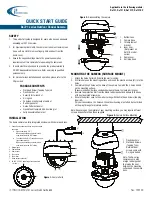
Configuring the Camera
Basler IP Camera
29
Stream AOI Left
- As shown in Figure 4 on
page 26
, sets the left offset (in pixels) for the stream
AOI, i.e., how far the stream AOI will be offset from the left edge of the image area captured by the
camera’s sensor. The setting must be a multiple of 8.
*
Stream AOI Top
- As shown in Figure 4 on
page 26
, sets the top offset (in pixels) for the stream
AOI, i.e., how far the stream AOI will be offset from the top edge of the image area captured by the
camera’s sensor. The setting must be a multiple of 2.
*
Stream AOI Width
- As shown in Figure 4 on
page 26
, sets the width (in pixels) of the stream
AOI. The setting must be a multiple of 8.
*
Stream AOI Height
- As shown in Figure 4 on
page 26
, sets the height (in pixels) of the stream
AOI. The setting must be a multiple of 8.
*
*
You can also use the
Stream AOI Editor
(see
page 33
) to set this parameter, and any changes
you make to the AOI parameter settings on the
Stream
tab will be reflected on the
Stream AOI
Editor
.
Output Scaling
- Sets the amount that captured images will be rescaled before they are encoded
and transmitted in the stream controlled by the currently selected tab.
1:1
= No rescaling.
1:2
= Rescale to 1/2 size.
1:4
= Rescale to 1/4 size.
1:8
= Rescale to 1/8 size.
Note that increasing the level of output scaling will decrease the workload on the processor in the
camera. For more information about the effects of processor workload, see Section 3.1 on
page 7
.
Frame Rate Scaling
- Sets the ratio of captured images to encoded images.
1:1
= Every image captured by the camera’s sensor will be encoded and streamed.
1:2
= Every second image captured by the camera’s sensor will be encoded and streamed.
1:4
= Every fourth image captured by the camera’s sensor will be encoded and streamed.
1:8
= Every eighth captured by the camera’s sensor will be encoded and streamed.
Note that increasing the level of frame rate scaling will decrease the bandwidth used to stream
images from the camera to a device.
GOP Length
- If the
Encoder Type
parameter is set to MPEG4 or H.264, then the
GOP Length
parameter will set the time between I-frames in milliseconds.
In an MPEG4 or an H.264 stream, the camera transmits periodic I-frames and transmits several
P-frames between each I-frame. I-frames carry complete information for a captured image.
P-frames only carry information about the areas of the image that have changed since the last
I-frame was transmitted. The time between the transmission of I-frames is determined by the
GOP
Length
parameter. Increasing the time between I-frames (i.e., the GOP length) will increase the
efficiency of the encoder. But be aware that increasing the GOP length also increases the latency
Summary of Contents for BIP-1000c
Page 4: ...Table of Contents ii Basler IP Camera...
Page 8: ...Introduction 4 Basler IP Camera...
Page 10: ...Accessing the Camera 6 Basler IP Camera...
Page 66: ...Configuring the Camera 62 Basler IP Camera...
Page 68: ...Reset Tool 64 Basler IP Camera...
Page 74: ...The Terminal Connector 70 Basler IP Camera...
Page 80: ...Day Night Functionality 76 Basler IP Camera...
Page 86: ...Technical Specifications 82 Basler IP Camera...
Page 92: ...Revision History 88 Basler IP Camera...
Page 94: ...Feedback 90 Basler IP Camera...
Page 98: ...Index 94 Basler IP Camera white balance mask 22 white balance mode parameter 15...
















































